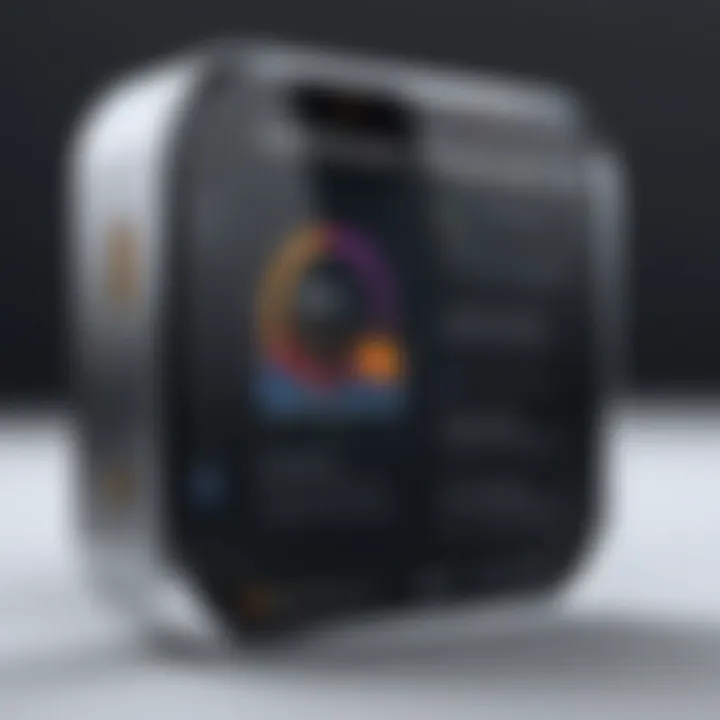Creating User Interfaces in Unity: A Comprehensive Guide


Intro
Creating efficient and user-friendly interfaces in Unity can drastically enhance the user experience for applications and games. Unity, a powerful game development engine, provides various tools and components for designing UIs that engage users. Understanding these components and their functionalities is essential for developers aiming to create intuitive experiences. This guide aims to explore the fundamental practices, advanced customization options, and optimization techniques. By delving into each aspect carefully, learners can elevate their skills and create seamless UIs that cater to their project's unique needs.
Understanding Unity’s UI System
Unity’s UI system is built around a canvas-based framework. This means that all UI elements must reside within a Canvas object. The Canvas manages the rendering of UI components, ensuring that they are displayed correctly on various devices and resolutions. Working within this framework allows for both 2D and 3D UIs, enhancing the versatility of your projects.
Key UI Components
There are several fundamental components when it comes to Unity's UI system:
- Button: Enables users to create interactive elements.
- Text: Displays text information.
- Image: Allows for visuals to be part of the UI.
- Input Field: Collects user input.
- Scrollbar: Provides navigation through content.
Understanding how to leverage these components will serve as a foundation for further exploration into UI design.
Layout Techniques
Creating an organized layout is vital in UI design. Unity offers various layout components to help developers control the placement and alignment of UI elements. These include:
- Horizontal Layout Group: Arranges child elements horizontally.
- Vertical Layout Group: Arranges child elements vertically.
- Grid Layout Group: Organizes items in a grid format.
Using these layout techniques ensures a responsive interface that adapts to different screen sizes.
Advanced Customization Options
For developers interested in going beyond the basics, Unity allows extensive customization of the UI components. Styles can vary significantly through:
- Anchors and Pivots: Control how UI responds to screen size changes.
- Animation: Enhance user interaction through animated transitions.
- Scripts: Integrate additional functionality via C# scripting.
By mastering these customization options, developers gain greater control over how users interact with their applications.
Best Practices in UI Design
Designing UIs is a craft requiring thoughtful consideration. Here are a few practices to keep in mind:
- Consistency: Maintain a uniform style throughout the application.
- Feedback: Always provide user feedback during interactions.
- Accessibility: Ensure your UI is usable for people with disabilities.
- Simplicity: Aim for a clean and straightforward layout.
These principles can significantly affect the usability of applications.
Performance Optimization
Optimizing UI performance is critical, especially for larger projects. Consider the following strategies:
- Minimize the number of canvases to reduce redraw calls.
- Use CanvasScaler for resolution adjustments.
- Optimize images and components to lower load times.
By implementing these optimizations, developers can create a smoother user experience.
Closure
Creating user interfaces in Unity involves a deep understanding of various concepts, components, and best practices. Through integrating responsive layouts, customizing elements, and adhering to optimization techniques, developers can craft interfaces that not only look appealing but also function seamlessly. This guide serves as an essential toolkit for those looking to enhance their skills in Unity UI design.
Prolusion to Unity User Interfaces
Understanding user interfaces in Unity is critical for developers aiming to create games and applications that are not only functional but also engaging. A well-designed UI can significantly enhance the user experience, making it intuitive and enjoyable. In this section, we will explore the importance of UI design in Unity and provide an overview of Unity's UI system.
Importance of UI Design in Unity
User interface design is the bridge between the user and the digital environment. In Unity, this means ensuring that players can navigate menus, interact with game elements, and receive feedback. Effective UI design influences user engagement and retention. Importantly, a well-structured interface can help avoid confusion or frustration for users.
- Enhances Usability: A clear UI makes it easier for users to understand game mechanics or application functions. It enables them to focus on their experience rather than struggling with controls.
- Increases Accessibility: A well-crafted UI considers various user needs, improving accessibility for individuals with disabilities. This inclusiveness can broaden your audience.
- Affects Aesthetics: User interfaces contribute to the overall visual appeal of a game or app. Consistent and aesthetically pleasing design can foster a positive emotional response from users.
In simple terms, investing time and effort into good UI design will often lead to a better reception and overall experience of your project.
Overview of Unity's UI System
Unity provides a robust framework for constructing user interfaces that range from simple overlays to intricate interactive components. This system allows developers to create dynamic and responsive UI elements using various tools and settings available within the editor.
- Canvas: The central component of UI in Unity. All UI elements are drawn relative to a canvas, which acts as a container.
- Prefab System: Unity’s prefab system allows for creating reusable UI components, making it simple to maintain consistency without replicating effort.
- Event System: It allows for interaction between UI elements and user inputs. Buttons respond to clicks, and sliders adjust based on user interaction.
By utilizing these features, developers can create sophisticated interfaces that are both functional and visually appealing. The flexibility of Unity's UI system accommodates a variety of design choices, from minimalistic to more elaborate presentations.
"Investing in UI design increases user satisfaction and retention – a cornerstone of successful applications."
In the following sections, we will delve deeper into fundamental concepts, core UI components, and advanced customization techniques, providing a thorough understanding of how to create engaging user interfaces in Unity.


Fundamental UI Concepts
Understanding fundamental UI concepts is crucial for anyone developing applications or games in Unity. A solid grasp of these elements lays the groundwork for creating effective and user-friendly interfaces. This section will explore RectTransforms, anchor points, and pivot settings, which are essential in structuring UI elements in a responsive manner. Familiarity with these concepts brings numerous benefits, such as improved layout flexibility, better screen adaptation across devices, and more efficient management of UI changes throughout the project lifecycle.
Understanding RectTransform
The RectTransform is a powerful component in Unity's UI system. Unlike the standard Transform used for 3D game objects, RectTransform is specifically designed for 2D elements in a user interface. It allows developers to define the position, size, and rotation of UI objects relative to their parent container. By adjusting the anchors and pivot settings, developers can create UI layouts that respond dynamically to different screen sizes and orientations.
For instance, a RectTransform can help position an element at the top right corner of the screen, regardless of the resolution. This is particularly important for mobile and multi-platform development. When designing interfaces, understanding how RectTransforms behave in relation to their parent can greatly streamline the design process.
Anchor Points and Pivot Settings
Anchor points and pivot settings are vital elements of the RectTransform. Anchors define the position of a UI element relative to its parent. By employing them effectively, developers can ensure that the interfaces maintain their layout when the screen size changes. For example, if a button is anchored to the top right corner, it will stay there even if the screen resizes or the orientation changes.
On the other hand, the pivot setting determines the point around which the RectTransform rotates and scales. By default, the pivot is set to the center of the UI element, but it can be adjusted to other points. Changing the pivot can create different visual effects during animations or transitions, enhancing user experience.
Proper use of anchor points and pivots allows for responsive designs, making your UI adaptable to various resolutions and aspect ratios.
Understanding these foundational concepts provides a clearer path toward mastering Unity's UI features. By leveraging RectTransforms, anchors, and pivot settings, developers can create dynamic and visually appealing user interfaces that enhance the overall experience of their applications.
Core UI Components in Unity
In Unity, the design and functionality of user interfaces rely heavily on Core UI Components. These components serve essential roles, allowing developers to create interactive and engaging applications. Understanding these components is fundamental for anyone looking to design effective UIs. By mastering them, one ensures that users have a seamless experience when navigating through the application or game.
These components not only enhance the visual appearance of the UI but also facilitate user interaction. This leads to overall better engagement with the application. Moreover, some components offer multiple states or behaviors, which can help in conveying important information to users about the current state of their actions.
Ultimately, knowing how to effectively implement these core components can streamline the development workflow, making it easier to build intuitive interfaces that meet the needs of various projects.
Text and Input Fields
Text and Input Fields are fundamental elements in any UI. They are used to display information and allow users to input data. Text components are essential to convey messages, labels, or instructions. Proper typography and sizing can significantly influence readability and user interaction. Meanwhile, Input Fields allow for user interaction, enabling them to enter text, numbers, or selections.
When designing Text and Input Fields, consider using Unity’s built-in styles. Custom styles can also be employed to match the thematic design of the game or application. This ensures a cohesive visual language.
Additionally, validation mechanisms are important. This involves ensuring data entered by the user meets specific requirements, like format or content length. Effective feedback informs the user of any issues during input.
Buttons and Toggle Elements
Buttons and Toggle Elements form the interactive part of a UI. Buttons trigger actions when clicked or tapped, while toggle elements allow users to make binary choices. This interaction is crucial in guiding user behavior. Using Unity's Button component, developers can easily set up events tied to user actions.
For accessibility, it is best to provide clear labels or icons that illustrate the expected action. Visual feedback upon interaction, such as color changes or animations, can enhance user experience.
Moreover, consider using toggle elements for options like settings. This gives users a straightforward way to enable or disable features. It is beneficial to group related toggles using layout components to maintain organized UI structure.
Sliders and Progress Bars
Sliders and Progress Bars give users the ability to make precise changes or observe progression within the application. Sliders allow for a range of values, such as volume levels or brightness settings. They are incredibly intuitive as users can see the effect of their adjustments in real-time.
On the other hand, Progress Bars inform users about progress in relation to specific tasks, such as loading screens or download indicators. Both components can be styled to match the UI theme. This fosters a seamless experience that feels well-integrated.
Using these components wisely can clarify the feedback loop between the system and its users, hence providing a sense of control.
Image and RawImage Components
Images play a significant role in delivering visual information in UIs. The Image component facilitates the display of graphics, icons, or illustrations that support the thematic elements of the application. With options for scaling, tiling, and transparency, images can enhance visual hierarchy and user understanding.
In contrast, the RawImage component allows for the display of textures. This can be particularly useful for rendering surfaces or images directly from a texture. When working with both components, it is essential to manage their resolution properly to maintain quality without compromising performance.
Images should be used thoughtfully to avoid clutter. The rich visual arrangement can draw the user’s eye but must be balanced with existing elements in the UI.
Layout Techniques for User Interfaces
The layout of user interfaces in Unity plays a crucial role in the overall usability of an application or game. A thoughtfully designed layout can significantly enhance user experience and optimize interactions. When users can easily navigate and understand the UI, they are more likely to engage with the content and the features offered. This section delves into essential layout techniques, emphasizing their importance, specific benefits, and considerations for effective use.
Using Layout Groups
Layout groups are powerful components that allow developers to arrange UI elements systematically. Unity provides several types of layout groups, such as Vertical Layout Group, Horizontal Layout Group, and Grid Layout Group. These provide an automatic arrangement of child elements, which brings clarity and harmony to your interface.
By using these groups, you can easily manage spacing, alignment, and distribution of UI components. For instance, a Vertical Layout Group aligns buttons vertically, ensuring a consistent gap between them. This not only saves time in manual alignment but also makes it easier to maintain your UI when changes occur.
Considerations when using layout groups include:
- Hierarchy Structure: Always consider the parent-child relationship in your hierarchy. Layout groups only affect their child objects.
- Content Size: Depending on the content, be mindful of how groups adapt to dynamic sizes and orientations.
Utilizing layout groups allows developers to create a fluid user experience while reducing development time.
Content Size Fitter Component


The Content Size Fitter component is an essential tool that works hand-in-hand with layout groups. It allows UI elements to automatically resize based on their content. When applied to a GameObject, the Content Size Fitter adjusts width and height based on the size of the content contained within it. This is especially relevant for text boxes or panels that can vary in size.
The component features two main settings: Horizontal Fit and Vertical Fit. Each can be set to either , , or , giving flexibility based on your needs. When designing UIs that need to accommodate variable-length text, such as user-generated comments or messages, this component is invaluable.
Overall, implementing the Content Size Fitter enhances the adaptability of UI layouts and ensures elements remain visually appealing regardless of changes in content.
Creating Responsive Layouts
Responsive layouts are paramount in modern UI design, especially when targeting multiple devices with different screen sizes. In Unity, achieving responsiveness involves a combination of layout groups, anchors, and resizing components. This responsiveness provides a seamless experience across desktops, tablets, and mobile devices.
To create a responsive UI:
- Utilize Anchors: Set anchors appropriately for each UI element. This ensures items remain in relative positions, adapting to different aspect ratios.
- Combine Layout Groups: Group elements logically to provide structure. This helps in automatic adjustments when screen sizes change.
- Test Across Devices: Regularly test your UI in various resolutions to identify potential issues and make adjustments as necessary.
"Creating responsive layouts not only saves development time but also ensures that users have a continuous experience no matter which device they use."
Advanced UI Customization
Advanced UI customization plays a crucial role in enhancing the user experience within Unity applications. It allows developers to tailor the user interface to specific project needs while maintaining consistency and aesthetics that resonate with the audience. Customization covers a range of components and techniques, enabling the creation of visually appealing and functional interfaces. Additionally, it encompasses several critical elements, such as custom styles, animations, and the effective use of canvas groups.
By focusing on advanced UI customization, developers can elevate their applications. Well-customized UIs can improve user engagement and satisfaction, making it easier for users to navigate and interact with the software. Keeping user-centered design principles in mind is pivotal when executing these customizations.
Custom UI Styles and Themes
Creating custom UI styles and themes is an essential aspect of personalization in Unity. By ensuring your project's visual identity aligns with its themes, you can significantly influence how users perceive and engage with the interface. Custom styles often include unique color palettes, fonts, and layout adjustments that enhance the overall aesthetics.
- Color Palettes: Selecting a coherent color scheme that reflects the mood of your project is essential. Tools such as Adobe Color or Coolors can assist in creating harmonious color combinations that fit different themes.
- Typography: Custom fonts can impact readability and the feel of your UI. Unity supports a variety of font styles, allowing you to choose those that align best with your project vision.
- Layout Variations: Adjusting the layout based on design requirements can improve user interactions. Utilizing Unity's layout system, you can create responsive layouts that adapt to various screen sizes and resolutions.
Through consistent and engaging UI styles, developers can create a memorable experience that fosters user loyalty.
Animations and Transitions
Animations and transitions are powerful tools to create a dynamic interface in Unity. They can guide the user's attention and provide visual feedback during interactions. This aspect of customization enhances usability by making interfaces feel more responsive and alive.
- Button Hover Effects: Implementing animations for buttons on hover can prompt users to interact with UI elements. Simple scaling or color changes can make buttons visually enticing.
- Panel Transitions: Smooth transitions for panels can enhance the flow of information. Use animations to create a seamless experience as users move through different sections of an application.
- Feedback Mechanisms: Animations can serve as subtle feedback for user actions. For instance, displaying a brief animation when a form is submitted can reassure users that the action was successful.
Overall, by integrating animations and transitions within UI design, developers can enrich the interaction experience and provide a sophisticated feel to their applications.
Using Canvas Groups for UI Element Management
Canvas groups in Unity are instrumental for managing the visibility and interaction of multiple UI elements. By grouping elements, developers gain more control over how these components behave and react to user inputs.
- Visibility Management: A canvas group allows you to show or hide multiple UI elements simultaneously. This is particularly useful during transitions or when toggling settings.
- Interaction Control: Canvas groups can disable interactions on all included elements, even while they remain visible. This is beneficial when you want to present information without allowing any user input.
- Alpha Control: Adjusting the alpha value of a canvas group can create fade-in or fade-out effects that enhance user experience during transitions.
The use of canvas groups simplifies UI management. It can lead to cleaner and more organized scripts, ultimately reducing development time while increasing maintainability.
"A well-designed UI is more than just aesthetics; it's about creating an intuitive, engaging experience for users."
In summary, advanced UI customization is a vital consideration for any developer working in Unity. By focusing on custom styles, animations, and effective organization through canvas groups, developers can create meaningful and engaging user experiences.
User Interface Scripting
User Interface Scripting serves as a fundamental backbone in the development of dynamic and interactive user interfaces in Unity. Through effective scripting, developers can handle events, interactions, and the overall behavior of UI elements. It automates responses to user inputs such as clicks, key presses, and gestures. Understanding how to leverage Unity's built-in scripting capabilities can greatly enhance the usability and functionality of any application or game, ensuring a seamless experience for users.
One key benefit of User Interface Scripting is the ability to create responsive interfaces. By writing scripts that monitor user actions, developers can immediately update UI elements. This can range from simple actions, such as changing the color of a button when hovered over, to more complex actions like updating a scoreboard in real time. Utilizing Unity's event system in conjunction with scripting allows for a responsive and polished user experience.
When considering User Interface Scripting, one must keep in mind performance implications. Overly complex scripts can lead to sluggish interactions. Therefore, it is important to optimize code and utilize appropriate event-driven programming paradigms. This focus on efficiency ensures that an application can handle multiple UI elements concurrently without lag.
"A well-implemented UI not only looks good, but it also works intuitively for the user."
Through scripting, developers can personalize UI elements to better align with the overall project goals. Moreover, understanding data binding, state management, and input handling allows for creating more engaging and interactive applications.
Interaction with UI Elements
Interacting with UI elements in Unity is a crucial aspect of User Interface Scripting. Through Unity's scripting environment, developers can respond to user actions. For instance, Button components come with built-in functionality to execute actions when clicked. By attaching scripts to these elements, it allows developers to define specific behaviors and reactions.
To effectively interact with UI elements, the button's onClick() event can be utilized. For example, consider the following code snippet:
In this example, a method is executed whenever the button is clicked, providing immediate feedback. Furthermore, interactive elements such as sliders or toggles can also be manipulated in a similar manner, allowing developers to listen and react to changes in values or states.
Event System Overview
Unity's Event System is integral for handling user interactions. It serves as a central hub for processing input from various devices, such as keyboard, mouse, or touch. Understanding the Event System is essential for any developer working on UIs in Unity as it organizes the various input events and dispatches them to the appropriate handlers.
Key components of the Event System include:


- EventSystem: This component controls the event dispatching and manages input modules.
- Standalone Input Module: This enables keyboard and mouse inputs.
- Touch Input Module: This is used in mobile environments.
The Event System uses a Raycast method to determine which UI elements are being interacted with. This determines how user actions, such as clicks or drags, are mapped to the UI. A proper configuration ensures that all user interactions are registered and handled effectively. By grasping these elements, developers can maximize the efficiency and responsiveness of their applications, paving the way for richer user experiences.
Best Practices for UI Development in Unity
User interface design in Unity is critical. Not only does it provide the visual aspect of a game or application, but it also serves as the conduit between the user and their experience. Applying the best practices in UI development ensures that applications are not just functional but also user-friendly and efficient. By focusing on usability, visual consistency, and performance, developers create interfaces that not only engage users but also enhance their overall experience.
User-Centered Design Principles
User-centered design (UCD) is an approach that places the user at the forefront of the design and development process. In Unity, this means understanding the needs and preferences of the target audience before starting to build the user interface. By implementing UCD principles, developers ensure that they are crafting interfaces that are intuitive and easy to navigate.
- Research Users: Begin with understanding who your users are. Conduct surveys or interviews to gather insights about their behaviors and preferences. This information can guide your design decisions.
- Create User Personas: Develop profiles that represent different user types. This practice helps in empathizing with users and tailoring interfaces to their specific needs.
- Prototyping and Testing: Use tools such as Unity Prototyping to create mockups of your UI early in the design phase. Gather feedback from real users to identify any areas of confusion or frustration. Iteration based on user testing is vital.
- Visual Hierarchy: Arrange UI elements in a way that naturally draws the user’s attention to the most important parts first. Use size, color, and contrast effectively to create a clear visual roadmap.
"A user-centered approach is not just about making things look good; it’s about making them work.”
Incorporating these design principles leads to interfaces that feel seamless and enhance the interaction between the user and the application.
Performance Optimization Techniques
Performance in UI design is fundamental for delivering a pleasant user experience. Slow or unresponsive interfaces can frustrate users, leading to disengagement. Consequently, implementing performance optimization techniques is essential.
- Minimize Draw Calls: Unity UI can be resource-intensive, especially if many elements need updating frequently. Reduce the number of draw calls by combining UI elements where possible. For instance, use a single image atlas for multiple UI images instead of separate files.
- Use Object Pooling: Reusing UI elements instead of instantiating and destroying them multiple times can greatly improve performance. Implementing object pooling for frequently used UI components can lead to a smoother experience.
- Optimize Animations: While animations can enhance user interaction, they can also consume resources. Use Unity's Animator efficiently and avoid using too many animation layers. Keep animations simple to maintain performance.
- Monitor with Profiler: Utilize Unity's Profiler to track performance issues. It allows you to visualize how the UI is performing during runs and pinpoint areas that consume too much processing power.
By following these performance techniques, developers can create user interfaces that are not only visually captivating but also highly efficient.
Adopting best practices for UI development in Unity is not just a recommendation but an obligation for developers looking to create standout applications. Properly executed user-centered design and rigorous performance optimization are keys to not just meeting but exceeding user expectations.
Testing and Debugging User Interfaces
Testing and debugging user interfaces is a crucial aspect of developing applications in Unity. It ensures that the UI functions as intended, providing a seamless experience for users. With complex UIs often involving multiple elements, interactions, and visual components, testing becomes necessary. This section will explore common UI issues developers face and the solutions available to overcome these challenges.
Common UI Issues and Solutions
When developing user interfaces, developers may encounter various issues. Understanding these common problems along with their solutions can save time and significantly improve the final product.
- Unresponsive UI Elements: Sometimes, buttons or sliders do not respond to user inputs. This can occur due to incorrect event configurations or issues with the Event System in Unity. Ensuring that each UI element has the appropriate settings and is within the active Canvas can avoid this problem.
- Misalignment and Overlapping Elements: Elements may not align correctly on different screen sizes. Adjusting anchor points and using layout groups can help create a more responsive design. Additionally, Unity’s Canvas Scaler component allows for better adaptation to various resolutions.
- Visibility Issues: Sometimes UI elements might appear hidden or obtrusive. This may result from incorrect Z-ordering or a misplaced Canvas Group component. Verifying the hierarchy and adjusting the sorting order should resolve these visibility concerns.
- Performance Hiccups: A poorly optimized UI can lead to frame drops, negatively impacting user experience. This often happens when numerous UI elements are active simultaneously. Limiting the active elements through the use of Canvas Groups or pooling techniques can help maintain performance.
Using Unity's Debugging Tools
Unity provides several powerful tools for debugging UI issues. Utilizing these tools effectively can lead to faster identification and resolution of problems.
- Console Window: This built-in feature allows developers to see warnings, errors, and logs during runtime. Using can help track important events in your UI, making it easier to find issues.
- UI Debugging Mode: Enable the UI Debugging mode to see detailed information about your UI elements. This can reveal hidden components, their sizes, and whether they are within the expected parameters.
- Profiler: This tool allows you to analyze how the UI affects performance. By examining the CPU and GPU times, developers can identify performance bottlenecks. Look for spikes in the performance graphs that may correspond with UI updates or interactions.
- Testing on Different Devices: Always test your UI on various devices and resolutions to identify how elements behave across different environments. Unity's Remote feature can simulate a mobile device while debugging on a PC.
Future Trends in Unity UI Development
In the rapidly evolving landscape of game development, keeping abreast of future trends in Unity UI development is essential. The user interface not only serves as the primary interaction medium between users and applications, but it also greatly influences user experience and satisfaction. As technologies advance, so too do the tools and methodologies utilized in UI creation. Understanding these trends equips developers with the necessary knowledge to craft responsive, engaging, and efficient interfaces.
Exploring UI Toolkit and New Features
The UI Toolkit has emerged as a focal point for Unity developers seeking modern solutions for user interface design. It presents a variety of new features that enhance usability and streamline workflows. Among these, the flexible layout system allows for more dynamic arrangements of UI elements, adapting seamlessly to various screen sizes and resolutions. Such flexibility is crucial given the vast array of devices users interact with today.
Another important aspect is the introduction of styles and resources that enable developers to maintain consistent design practices. This includes the ability to create custom themes and stylesheets that can be reused across different projects. This not only improves efficiency but also fosters a recognizable brand identity.
"The UI Toolkit represents a fundamental shift towards more intuitive and accessible UI design in Unity."
Moreover, Unity is focusing on performance enhancements. As applications become more complex, optimizing user experience without compromising performance becomes critical. The UI Toolkit supports better utilization of GPU resources, resulting in smoother transitions and animations. The integration of these features encourages developers to implement high-quality designs while keeping performance in check.
In summary, staying informed about the UI Toolkit and its new features can significantly influence the development process in Unity. Understanding and adapting to these trends is not merely optional; it is crucial for creating user interfaces that are both functional and engaging.
End
In this article, we explored the comprehensive landscape of creating user interfaces in Unity. The importance of a well-designed user interface cannot be overstated. It serves as the gateway for users to engage with your application or game, dictating their experience and satisfaction levels. An intuitive UI enhances usability and fosters user retention.
To summarize the critical components we've discussed:
- Key Learnings: We analyzed the foundational concepts necessary for a robust UI, including the RectTransform and various core elements such as buttons, sliders, and text inputs. We also delved into layout techniques ensuring adaptability across multiple devices.
- Customization: Advanced UI customization allows developers to create unique experiences through animations and thematic designs, essential for standing out in a competitive market.
- Scripting Interactions: Knowing how to script interactions effectively is crucial for creating responsive and dynamic UIs that react to user inputs.
- Best Practices: By adhering to user-centered design principles and performance optimization techniques, developers can ensure their UIs not only look good but also perform efficiently.
- Debugging: We touched on common UI issues and how to leverage Unity's debugging tools to maintain seamless functionality.
"A well-crafted user interface is the silent player in the game of user engagement."
Finally, as you move forward with your Unity projects, keep in mind the importance of iterative testing and feedback. Engaging with your users and understanding their needs will guide you in making informed adjustments to your UI design and functionality, ultimately leading to a more successful product.
Summary of Key Learnings
We have highlighted the key concepts essential for crafting effective UIs in Unity. From the fundamental components of UI design to advanced customization techniques, each aspect contributes to a cohesive user experience. This foundation empowers developers to create interfaces that prioritize usability and aesthetic appeal, catering to a wide range of users. The practical tips provided throughout serve as a guide for implementing these concepts in real-world applications.
Starting Your UI Project in Unity
Commencing your UI project in Unity involves several strategic steps. Begin by defining the user needs and the goals for your application. It is essential to sketch out the core functionalities your UI must support.
Next, familiarize yourself with Unity's Canvas system, as it is the backbone of UI creation. Start by adding a Canvas to your scene, then gradually build out your UI elements, ensuring to follow best practices for layout and design as discussed earlier. Utilize Unity's built-in components effectively, and do not hesitate to make use of the Asset Store for additional resources that can enhance your design.
Remember to maintain a focus on adaptability and performance during development. Implement responsive layouts that cater to different screen sizes and resolution. Finally, continually ask for feedback from potential users and iterate upon your design to improve usability and satisfaction.





